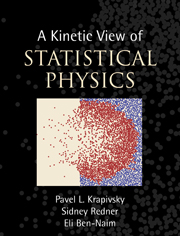1 - Aperitifs
Published online by Cambridge University Press: 05 March 2013
Summary
Non-equilibrium statistical physics describes the time evolution of many-particle systems. The individual particles are elemental interacting entities which, in some situations, can change in the process of interaction. In the most interesting cases, interactions between particles are strong and hence a deterministic description of even a few-particle system is beyond the reach of any exact theoretical approach. On the other hand, many-particle systems often admit an analytical statistical description when their number becomes large. In that sense they are simpler than few-particle systems. This feature has several different names – the law of large numbers, ergodicity, etc. – and it is one of the reasons for the spectacular successes of statistical physics and probability theory.
Non-equilibrium statistical physics is also quite different from other branches of physics, such as the “fundamental” fields of electrodynamics, gravity, and high-energy physics that involve a reductionist description of few-particle systems, as well as applied fields, such as hydrodynamics and elasticity, that are primarily concerned with the consequences of fundamental governing equations. Some of the key and distinguishing features of non-equilibrium statistical physics include the following:
• there are no basic equations (like Maxwell equations in electrodynamics or Navier–Stokes equations in hydrodynamics) from which the rest follows;
• it is intermediate between fundamental and applied physics;
• common underlying techniques and concepts exist in spite of the wide diversity of the field;
• it naturally leads to the creation of methods that are useful in applications outside of physics (for example the Monte Carlo method and simulated annealing).
- Type
- Chapter
- Information
- A Kinetic View of Statistical Physics , pp. 1 - 11Publisher: Cambridge University PressPrint publication year: 2010



